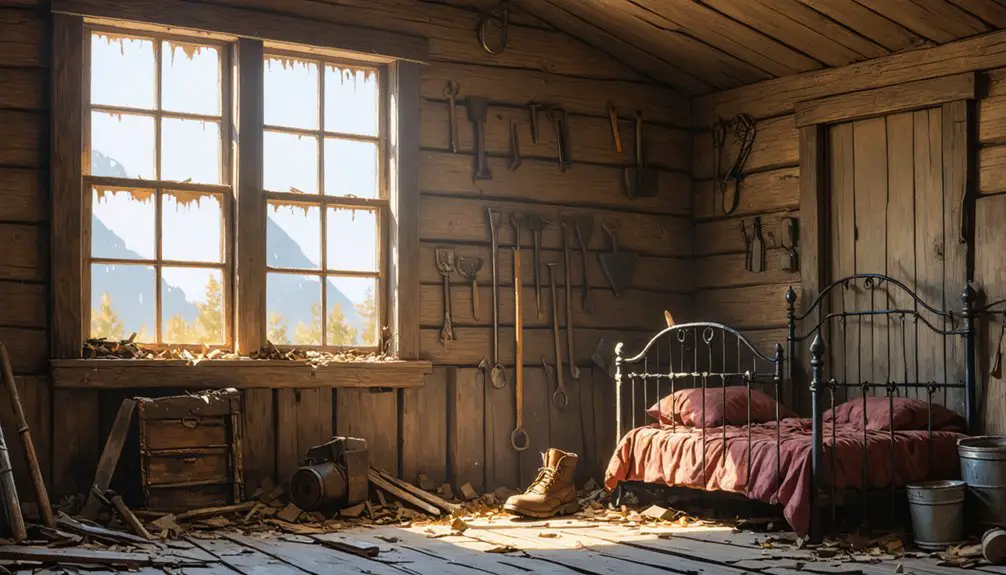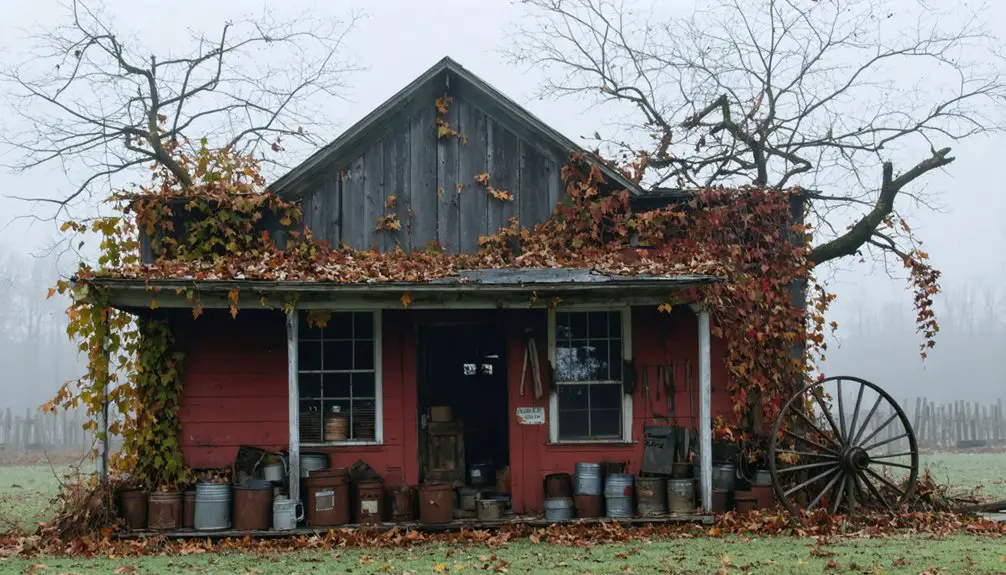You’ll find the ghost town of Manseau in Michigan’s Leelanau Peninsula, where Antoine Manseau built a grist mill on Kenosha Creek in 1859. The mill thrived as an essential grain-processing hub until 1906 when the Belanger family took over operations. By 1934, declining grain production forced the mill’s closure, leaving behind three haunting remnants: an empty mill building, concrete ruins, and the Belanger Pond dam. Local folklore whispers of supernatural occurrences among these historic structures.
Key Takeaways
- Manseau was established in 1859 as a mill town on Kenosha Creek, becoming the region’s oldest grist mill until closing in 1934.
- The abandoned settlement features three main remnants: an empty mill building, concrete ruins, and the intact Belanger Pond dam.
- Local folklore includes stories of ghostly apparitions, witchcraft, and mysterious Melon Heads lurking in surrounding woods at night.
- The town declined due to failing grain production and farmers switching to cherry crops in the early 20th century.
- The site is listed on Michigan’s Historic Places, preserving remnants of the once-thriving mill town community.
The Birth of a Mill Town (1859)
In 1859, Antoine Manseau established a pivotal grist mill on Kenosha Creek, originally known as Keywatosa Creek after a local Native American chief. The 26-by-30-foot structure would soon become the region’s oldest grist mill and a cornerstone of local commerce.
You’d have found Manseau’s mill just south of Omena, where Belanger Pond now sits. By damming the creek, Manseau created the power source for his state-of-the-art operation, featuring French millstones and an impressive system of 56 belts driving the flour-producing rollers. The Belanger family purchased and operated the facility until the mill operated successfully until business declined significantly in 1934 due to reduced grain production in the area.
The mill quickly became a hub for community gatherings as local farmers brought their grain for processing. With its own railroad siding on the Traverse City to Northport route, the mill helped transform this remote spot into a crucial agricultural center in the Grand Traverse area.
Antoine Manseau’s Vision Along Kenosha Creek
When Antoine Manseau purchased land along Kenosha Creek for $100 in 1856, he’d already envisioned transforming the natural waterway into an essential economic hub. As a skilled carpenter and millwright, you can imagine how he saw the creek’s potential, teeming with fish and surrounded by wild berries in Kenosha’s ecosystem.
By 1859, he’d built a 26-by-30-foot grist mill, installing imported millstones to serve local farmers. Antoine’s legacy took shape as the mill became more than just a grain-processing facility – it evolved into a significant community center with its own railroad siding on the Traverse City to Northport route. Born in Canada in 1810, Antoine brought his expertise in carpentry to Michigan, where his vision would permanently shape the region. The mill remained operational until declining grain production in the Grand Traverse region forced its closure in 1934.
Though never an official town, the mill site marked the beginning of substantial economic development south of Omena, fundamentally changing the region’s landscape.
The Belanger Family Legacy
The Belanger family’s influence on Manseau’s legacy began in 1906, as Eugene Belanger and his four sons – Ignatius, Alexis, Luke, and Edwin – purchased the historic mill that had been operating since 1859.
The mill was initially named Keywatosa Creek when first constructed by Antoine Manseau. The Belanger lineage ran deep in the region, with Eugene’s marriage to Emma Rosa Deerwood strengthening local family connections. The family followed a long tradition of French settlers who had established roots in the area. Together with his sons, they transformed the mill into a crucial hub for local grain farmers.
- You’ll find their impact lasted 28 years until 1934
- They maintained advanced milling technology for their era
- They created a dam on Belanger Creek that still exists today
- Their family ties extended through marriages like Melina Manseau’s
The mill’s closure in 1934, following structural failure and declining grain farming, marked the end of their operational legacy.
Though the site remains a symbol of their entrepreneurial spirit.
Water-Powered Operations and Agricultural Impact
You’ll find the Manseau Mill’s ingenious engineering system relied on water from Kenosha Creek, channeled through a dam at Belanger Pond to power its grinding mechanisms.
Much like the water-powered sawmill that operated in North Manitou Village, the mill’s strategic location and water-powered setup made it the region’s primary grain processing facility from 1859 to 1934, serving countless local farming families.
The mill’s economic decline eventually led to its abandonment, reflecting a common pattern in Michigan’s industrial heritage.
When farmers brought their grain to the mill, they’d witness the impressive sight of water energy converting their crops into flour through a complex network of wheels, gears, and millstones that operated year-round.
Mill Engineering Systems
Water-powered operations at Manseau’s Mill began in 1859 when Antoine Manseau constructed a dam across Keywatosa Creek, establishing what would become an essential agricultural hub for the Grand Traverse region. Similar to the Copper Falls Mine and other abandoned sites, this industrial operation proved vital to early development.
The mill’s engineering showcased the ingenuity of 19th-century technology, with its carefully designed water management system powering French millstones known for their durability. Like many ghost towns in Michigan, Manseau’s fate was sealed when local industry declined.
- The 26×30-foot wooden structure housed a sophisticated sluice system that regulated water flow from Belanger Pond.
- A water box controlled the precise amount of power delivered to the mill wheel.
- The dam created a reliable water source that could operate consistently throughout growing seasons.
- French-imported millstones provided superior grinding capability until the mill’s closure in 1934 due to agricultural decline.
Regional Grain Processing Impact
During its 75-year operation, Manseau Mill transformed the agricultural landscape of Leelanau County by processing local grain through its innovative water-powered system.
You’d find farmers bringing their wheat to the 26-by-30-foot facility, where 56 belts powered by Kenosha Creek’s dam turned imported French millstones. This setup wasn’t just efficient – it was environmentally friendly compared to steam-powered alternatives of the era.
The mill’s impact on the local economy went beyond grain processing. With its railroad siding connecting to the Traverse City-Northport route, farmers could easily transport their processed grain to broader markets.
This transportation hub helped sustain local agriculture until the 1930s, when regional grain production declined and the mill’s structure ultimately failed in 1934.
Local Legends and Folklore

Like many abandoned settlements across Michigan, Manseau harbors its share of haunting tales and supernatural legends. The town’s eerie atmosphere has given rise to stories of ghostly apparitions and witchcraft curses that continue to captivate locals and visitors alike.
- You’ll hear whispers of young spectral girls seen gliding between the abandoned homes at dusk, their ethereal forms vanishing when approached.
- Local accounts tell of witchcraft practitioners who once lived in the area, their alleged curses still affecting those who disturb certain locations.
- You might encounter the infamous Melon Heads if you venture into the surrounding woods at night, with some claiming to have seen their enlarged silhouettes lurking among the trees.
- The most heartbreaking tales involve mourning spirits, including a mother who’s said to still cradle her deceased child in one of the derelict houses.
The Final Days of Production
You’ll notice the rapid decline in farm crop yields during 1934, which severely impacted the Manseau Mill’s ability to maintain viable production levels.
When the mill’s concrete water box wall catastrophically failed, sending planking a hundred yards across the frozen bay, the Belanger family knew they’d reached a critical turning point.
The workers completed their final shift shortly after this incident, bringing an end to decades of milling under the Belanger family’s stewardship since their 1906 purchase.
Declining Farm Crop Yields
As grain production steadily declined in the early 20th century, Manseau’s agricultural landscape began showing signs of irreversible change.
You’d have seen the impact of failing crop sustainability across the region, with the historic Manseau Mill struggling to maintain operations until its closure in 1934.
The agricultural shifts that shaped Manseau’s destiny unfolded in these key ways:
- Local farmers watched their grain yields drop dramatically, forcing many to abandon their fields.
- The Manseau Mill’s concrete wall collapsed in ’34, marking the end of local grain processing.
- Farmers shifted from traditional cereal crops to alternatives like cherries on the Leelanau Peninsula.
- Agricultural infrastructure deteriorated as farming families left, transforming Manseau into a ghost town.
Water System’s Fatal Break
The mounting agricultural troubles in Manseau reached their breaking point with a devastating water system failure at the town’s mill.
You’ll find it wasn’t just bad timing – this catastrophe marked the final chapter in Manseau’s story of community decline.
After the mill’s last day of production in 1934, the concrete wall of the water box suddenly gave way, sending planking drifting 100 yards across the frozen bay.
While workers had narrowly escaped injury by finishing their shifts earlier, the water infrastructure challenges proved insurmountable.
You can still see the dam at Belanger Pond today, but that fatal break effectively ended any chance of reviving mill operations.
Without sufficient funds to repair the system, like many rural Michigan towns, Manseau’s essential water supply infrastructure crumbled into history.
Workers’ Last Mill Shift
When Edwin Belanger and his brothers arrived for their final shift at Manseau Mill in 1934, they couldn’t have known they’d be the last workers to operate its aging machinery.
The day marked the end of an era for this northern Michigan landmark, where generations of millers had processed local grain.
You can trace the last shift’s events through worker memories:
- Edwin and his brothers worked the deteriorating equipment as grain supplies dwindled.
- The workforce pushed through their duties amid the mill’s failing infrastructure.
- They completed their shift and headed home to nearby Suttons Bay.
- Hours later, the concrete wall of the water box crumbled, and floor planks scattered onto the frozen bay.
The timing proved fortunate – had the collapse happened during working hours, the outcome might’ve been tragic.
What Remains Today
Today you’ll find three main remnants of Manseau’s once-bustling mill town: the empty mill building itself, concrete ruins including a partially collapsed water box wall, and the intact dam on Belanger Pond.
The serene waters still reflect these abandoned structures, while the surrounding natural landscape has helped preserve what’s left of the site’s history.
You can explore the foundations and old planking materials scattered around the property – some dating back to 1934 when they shifted onto the bay ice.
While the mill building stands as a silent sentinel, it’s been empty for nearly a century.
The site’s official listing on Michigan’s Historic Places offers protection for these remaining features, though nature slowly reclaims more of the ghost town with each passing year.
Michigan’s Rural Industrial Heritage
Michigan’s rural industrial landscape underwent dramatic transformation during the late 19th and early 20th centuries, as traditional water-powered mills gave way to more mechanized operations.
You can trace this evolution through the region’s rich industrial heritage:
- In the Saginaw River Valley, sawmills exploded from just 6 in 1840 to 200 by 1885, showing how quickly the rural economy adapted to commercial-scale production.
- Henry Ford’s Village Industries program revolutionized rural manufacturing after WWI by converting old mill sites into modern factories along the Rouge River.
- These small factories blended industrial integration with farming life, letting rural workers maintain their agricultural roots while earning factory wages.
- The transformation didn’t just change the landscape – it reshaped entire communities, as new technology and scientific farming methods modernized traditional rural life.
Frequently Asked Questions
What Was the Total Population of Manseau Mill at Its Peak?
You won’t find an exact population census, but during peak years, Manseau Mill likely housed between 25-75 residents, based on local records showing Leland’s total population of 200 in 1867.
Were There Any Schools or Churches Established in Manseau Mill?
While you might expect to find schools and churches in a mill town, there’s no historical evidence of either in Manseau Mill. Other nearby settlements used multipurpose buildings for both educational and religious gatherings.
How Did Residents Access Medical Care in the Manseau Mill Community?
You’d find basic healthcare access through a local doctor, but medical challenges meant relying on home remedies, community support, and difficult travel to larger towns for serious treatment.
What Were the Primary Transportation Routes Connecting Manseau Mill to Nearby Towns?
You’d find two incredibly essential arteries: the bustling Traverse City to Northport Railroad with its dedicated mill siding, and the local road networks connecting through the distinctive hump near Belanger Pond’s current location.
Did Any Other Businesses Besides the Mill Operate in Manseau?
You won’t find records of a general store or blacksmith shop in this settlement – sources indicate it was primarily a mill-centered operation without other documented commercial enterprises.
References
- https://99wfmk.com/north-manitou-island/
- https://omenapreservation.org/omenas-ghost-towns/
- https://kids.kiddle.co/List_of_ghost_towns_in_Michigan
- https://gandernewsroom.com/2023/06/28/7-michigan-ghost-towns-you-might-not-find-on-your-map-2/
- https://en.wikipedia.org/wiki/List_of_ghost_towns_in_Michigan
- https://lostinmichigan.net/belanger-mill/
- https://lostinmichigan.net/category/mills/
- https://kewauneecountyhistory.blogspot.com/2015/10/
- https://grandtraverse.genealogyvillage.com/books/histnorthmi&itspeople.pdf
- http://genealogytrails.com/mich/leelanau/bioM.html


